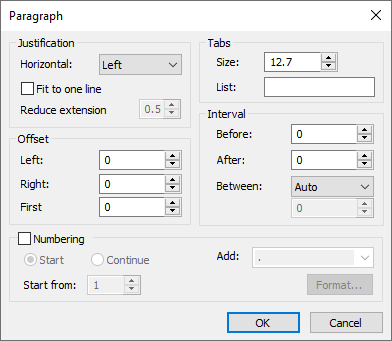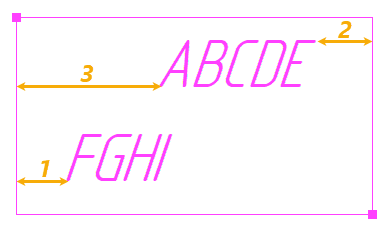Paragraph Parameters of Text |
  
|
Initially, text creation command uses default paragraph parameters. Next, user can customize paragraph parameters either for the whole created text using the text parameters dialog, or individually for selected part of the text in the content editing mode.
Font parameters for selected part of text are customized using the paragraph parameters dialog or special commands. If nothing is selected, then font parameters are set for the current position of text cursor.
When inputting the text content, new paragraphs are added by pressing <Enter>. In order to wrap a textual string to the new line without creating a new paragraph, press <Shift>+<Enter>.
Commands for paragraph parameters customization
Following commands are available at the Text tab of the ribbon within the text content editing mode and at the Format toolbar in the text editor:
Icon |
Ribbon |
|---|---|
|
Text > Font > Left Text Alignment |
Keyboard |
Textual Menu |
<Ctrl>+<L> |
|
Aligns text with the left edge of bounding rectangle or table cell.
Icon |
Ribbon |
|---|---|
|
Text > Font > Center Text Alignment |
Keyboard |
Textual Menu |
<Ctrl>+<T> |
|
Aligns text with the center of bounding rectangle or table cell.
Icon |
Ribbon |
|---|---|
|
Text > Font > Right Text Alignment |
Keyboard |
Textual Menu |
<Ctrl>+<H> |
|
Aligns text with the right edge of bounding rectangle or table cell.
Icon |
Ribbon |
|---|---|
|
Text > Font > Text Justification |
Keyboard |
Textual Menu |
<Ctrl>+<J> |
|
Aligns text with both vertical edges of bounding rectangle or table cell by increasing spacing between words.
Icon |
Ribbon |
|---|---|
|
Text > Font > Text Numbering |
Keyboard |
Textual Menu |
<Ctrl>+<M> |
|
Enables numbering of paragraphs. Numbering parameters may be customized using the paragraph parameters dialog. If ![]() Non-printable characters are enabled, then identifiers of each numbered paragraph are displayed. Identifier may differ from actual number of the paragraph.
Non-printable characters are enabled, then identifiers of each numbered paragraph are displayed. Identifier may differ from actual number of the paragraph.

Within the text content editing mode the dialog can be called using the following automenu command:
|
<F10> |
Format Paragraph |
Moreover, it can be called from the contextual menu (![]() Paragraph... <F10>).
Paragraph... <F10>).
Within the text editor it can be called from the Format toolbar, from the contextual menu and from the drop-down menu (Format > ![]() Paragraph...).
Paragraph...).

Following groups of parameters are available in the dialog:
Justification
Contains following controls intended for text's horizontal alignment customization:
•Horizontal
One of the following options can be selected in the drop-down list: ![]() Left,
Left, ![]() Center,
Center, ![]() Right,
Right, ![]() Justify. Applying this options has the same effect as using the ribbon commands described above.
Justify. Applying this options has the same effect as using the ribbon commands described above.
•Fit to one line
Enable this checkbox, when you need to fit the whole paragraph in one line. In this case, the font characters are first scaled by the width to the minimum ratio defined in the Reduce extension input box. If that's not enough, then the font height is reduced.
•Reduce extension
Minimal scale ratio applied upon enabling the Fit to one line checkbox.
Since bounding rectangle of multiline text expands automatically upon increasing the size of its content, then enabling the Fit to one line checkbox for multiline text has no effect.
Tabs
Contains following input boxes intended for customizing the effect of pressing <Tab>:
•Size
The distance of textual cursor's movement upon pressing <Tab> in absolute length values (by default it's either millimeters, or inches depending on the standard of the current document).
•List
Type in several numbers separated by commas. Numbers are automatically sorted in ascending order. They define distance between left edge of bounding rectangle and textual cursor's position. E.g.: if the List contains 20,40,50, then upon pressing <Tab> for the first time, the cursor will be placed at 20 units distance from the left edge, upon pressing <Tab> for the second time - at 40 units distance, third time - 50 units. Thereafter, the tabulations use the distance specified in the Size input box.
Offset
Contains following controls intended for customizing the distance between edges of bounding rectangle and text content:

1 - Left, 2 - Right, 3 - First.
Keep in mind, that within the text content editing mode the appearance of bounding rectangle doesn't represent its actual dimensions. The rectangle looks bigger than it is, due to additional offsets displayed for more convenient content editing.
Interval
Contains following controls intended for customizing the distance between lines of text:
•Before
The distance between the bottom of previous paragraph's last line and the top of current paragraph's first line.
•After
The distance between the bottom of current paragraph's last line and the top of next paragraph's first line.
•Between
The distance between bottoms of current paragraph's lines. Following options are available in the drop-down list:
oAuto
The distance is set automatically depending on a max height of line's content.
oMinimum
The minimal distance value is typed in below the drop-down list. If the line's content doesn't fit such distance, the distance is increased automatically.
oExactly
The exact distance value is typed in below the drop-down list. Such distance is applied regardless of line's content size. If indexes, fractions or radicals don't fit, then their size is reduced automatically. If other types of content don't fit, then the part, that didn't fit, is omitted.
oFactor
The distance is defined as a font height multiplied by a ratio typed in below the drop-down list.
Numbering
Enabling this checkbox enables the automatic numbering of paragraphs in the same way as the ![]() Text Numbering command. Next there's the switch with two possible states:
Text Numbering command. Next there's the switch with two possible states:
•Start
Numbering of selected paragraphs starts from the number typed into the Start from input box.
•Continue
Numbering of selected paragraphs either continues the numbering of previous paragraph (if possible), or starts from 1.
The symbol to be added after the paragraph's number can be typed into the Add input box or selected from the list ![]() .
.

Numbering font is defined separately from font of the rest of the text. The Format... button invokes the numbering font parameters dialog. Such dialog contains the same set of parameters as the regular font parameters dialog.